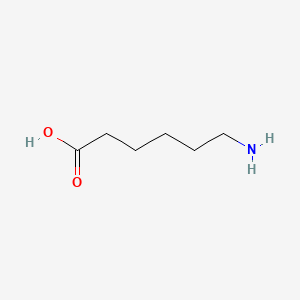| MeSH term | MeSH ID | Detail |
|---|---|---|
| Hemolysis | D006461 | 131 associated lipids |
| Uremia | D014511 | 33 associated lipids |
| Stomach Ulcer | D013276 | 75 associated lipids |
| Diabetes Mellitus | D003920 | 90 associated lipids |
| Sarcoma, Experimental | D012513 | 13 associated lipids |
| Adenocarcinoma | D000230 | 166 associated lipids |
| Lupus Erythematosus, Systemic | D008180 | 43 associated lipids |
| Hyperglycemia | D006943 | 21 associated lipids |
| Wounds and Injuries | D014947 | 20 associated lipids |
| Kidney Neoplasms | D007680 | 29 associated lipids |
6-aminohexanoic acid
6-aminohexanoic acid is a lipid of Fatty Acyls (FA) class. 6-aminohexanoic acid is associated with abnormalities such as Blood Clot, Myocardial Infarction, Cerebrovascular accident, Renal impairment and Scoliosis, unspecified. The involved functions are known as Fibrinolysis, Agent, Hemorrhage, plasminogen activation and inhibitors. 6-aminohexanoic acid often locates in Chest, Blood, Body tissue, peritoneal and Plasma membrane. The associated genes with 6-aminohexanoic acid are P4HTM gene, BSND gene, MTPN gene, NDUFS4 gene and Homologous Gene. The related lipids are Phosphatidylserines and Butyric Acid.
Cross Reference
Introduction
To understand associated biological information of 6-aminohexanoic acid, we collected biological information of abnormalities, associated pathways, cellular/molecular locations, biological functions, related genes/proteins, lipids and common seen animal/experimental models with organized paragraphs from literatures.
What diseases are associated with 6-aminohexanoic acid?
6-aminohexanoic acid is suspected in Cerebrovascular accident, Blood Clot, Myocardial Infarction, Renal impairment, Thromboembolism, Postoperative myocardial infarction and other diseases in descending order of the highest number of associated sentences.
Related references are mostly published in these journals:
| Disease | Cross reference | Weighted score | Related literature |
|---|
Possible diseases from mapped MeSH terms on references
We collected disease MeSH terms mapped to the references associated with 6-aminohexanoic acid
PubChem Associated disorders and diseases
What pathways are associated with 6-aminohexanoic acid
There are no associated biomedical information in the current reference collection.
PubChem Biomolecular Interactions and Pathways
Link to PubChem Biomolecular Interactions and PathwaysWhat cellular locations are associated with 6-aminohexanoic acid?
Visualization in cellular structure
Associated locations are in red color. Not associated locations are in black.
Related references are published most in these journals:
| Location | Cross reference | Weighted score | Related literatures |
|---|
What functions are associated with 6-aminohexanoic acid?
Related references are published most in these journals:
| Function | Cross reference | Weighted score | Related literatures |
|---|
What lipids are associated with 6-aminohexanoic acid?
Related references are published most in these journals:
| Lipid concept | Cross reference | Weighted score | Related literatures |
|---|
What genes are associated with 6-aminohexanoic acid?
Related references are published most in these journals:
| Gene | Cross reference | Weighted score | Related literatures |
|---|
What common seen animal models are associated with 6-aminohexanoic acid?
There are no associated biomedical information in the current reference collection.
NCBI Entrez Crosslinks
All references with 6-aminohexanoic acid
Download all related citations| Authors | Title | Published | Journal | PubMed Link |
|---|---|---|---|---|
| Troianos CA et al. | The effect of prophylactic epsilon-aminocaproic acid on bleeding, transfusions, platelet function, and fibrinolysis during coronary artery bypass grafting. | 1999 | Anesthesiology | pmid:10443606 |
| Levy JH | Hemostatic agents and their safety. | 1999 | J. Cardiothorac. Vasc. Anesth. | pmid:10468243 |
| Medina Pérez A and De las Nieves MA | [Antifibrinolytics as a treatment for severe factor XI deficiency in laryngeal surgery]. | 1999 | Sangre (Barc) | pmid:10481596 |
| Kornblatt JA et al. | The effects of hydrostatic pressure on the conformation of plasminogen. | 1999 | Eur. J. Biochem. | pmid:10491165 |
| Dalmau A et al. | Comparative study of antifibrinolytic drugs in orthotopic liver transplantation. | 1999 | Transplant. Proc. | pmid:10500617 |
| Conley JC and Plunkett PF | Antithrombin III in cardiac surgery: an outcome study. | 1998 | J Extra Corpor Technol | pmid:10537578 |
| Igarashi A and Yamaguchi M | Increase in bone protein components with healing rat fractures: enhancement by zinc treatment. | 1999 | Int. J. Mol. Med. | pmid:10567672 |
| Casati V et al. | Hemostatic effects of aprotinin, tranexamic acid and epsilon-aminocaproic acid in primary cardiac surgery. | 1999 | Ann. Thorac. Surg. | pmid:10617012 |
| Fujimoto T et al. | Development of a latex immunoturbidimetric assay for the automated measurement of alpha2 plasmin inhibitor-plasmin complex in human plasma. | 1999 | Semin. Thromb. Hemost. | pmid:10632477 |
| Strømgaard K et al. | Solid phase synthesis and biological evaluation of enantiomerically pure wasp toxin analogues PhTX-343 and PhTX-12. | 2000 | Chirality | pmid:10637415 |
